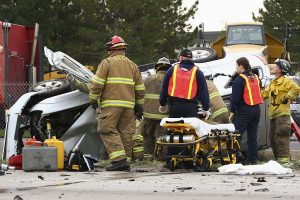 Women with diabetes have more to manage. Stay on track by checking your blood sugar often, eating healthy food, and being active so you can be your healthiest and feel your best.
Women with diabetes have more to manage. Stay on track by checking your blood sugar often, eating healthy food, and being active so you can be your healthiest and feel your best.
How is diabetes different for women than it is for men? Diabetes increases the risk of heart disease(https://www.cdc.gov/heartdisease/) (the most common diabetes complication) by about four times in women but only about two times in men, and women have worse outcomes after a heart attack. Women are also at higher risk of other diabetes-related complications such as blindness, kidney disease, and depression.
Not only is diabetes different for women, it’s different among women—African American, Hispanic/Latina, American Indian/Alaska Native, and Asian/Pacific Islander women are more likely to have diabetes than white women.
How you manage diabetes may need to change over time depending on what’s happening in your life. Here’s what to expect and what you can do to stay on track.
Yeast and Urinary Tract Infections
Many women will get a vaginal yeast infection(https://www.cdc.gov/fungal/diseases/candidiasis/genital/) at some point, but women with diabetes are at higher risk especially if their blood sugar levels are high.
More than 50% of women will get a urinary tract infection(https://www.cdc.gov/antibiotic-use/community/for-patients/common-illnesses/uti.html) (UTI) in their lifetime, and your risk may be higher if you have diabetes. Causes include high blood sugar levels and poor circulation (which reduces your body’s ability to fight infections). Also, some women have bladders that don’t empty all the way because of diabetes, creating a perfect environment for bacteria to grow.
What You Can Do: To prevent yeast infections and UTIs, keep your blood sugar levels as close to your target range as possible. Other ways to prevent UTIs: drink lots of water, wear cotton underwear, and urinate often instead of waiting until your bladder is full.

You can’t go wrong with the basics: check your blood sugar regularly, eat healthy food, and be active on most days.
Make Friends With Your Numbers
Sometimes having high blood sugar can feel like a test you didn’t pass. But numbers are just numbers. Think of them instead as information. Did a certain food or activity make your levels go up or down? Armed with that knowledge, you can make adjustments and get closer to your target range more often.
Menstrual Cycle
Changes in hormone levels right before and during your period can make blood sugar levels hard to predict. You may also have longer or heavier periods, and food cravings can make managing diabetes harder. You may notice a pattern over time, or you may find that every period is different.
What You Can Do: Check your blood sugar often and keep track of the results to see if there’s a pattern. If you use insulin, you might need to take more in the days before your period. Talk to your doctor about changing your dosage if needed. Being active on most days, eating healthy food in the right amounts, and getting enough sleep can all help too.
Sex
Diabetes can lower your interest in sex and your ability to enjoy it. For some women, vaginal dryness can make intercourse uncomfortable or even painful. Causes can include nerve damage, reduced blood flow, medications, and hormonal changes, including those during pregnancy or menopause.
What You Can Do: Be sure to talk to your doctor if you’re having any sexual issues. He or she can let you know your options, from using vaginal lubricants to doing exercises that can increase sexual response.
Birth Control
It’s important to use birth control if you don’t want to become pregnant or if you want to wait until your blood sugar levels are in your target range, since high blood sugar can cause problems during pregnancy for you and your baby. There are many types of birth control methods, including intrauterine devices (IUDs), implants, injections, pills, patches, vaginal rings, and barrier methods like condoms and diaphragms. Choosing the right option for you will depend on whether you have any other medical conditions, current medicines you take, and other factors.
What You Can Do: Talk with your doctor about all your birth control options and risks. Continue checking your blood sugar, track the results, and let your doctor know if your levels go up.
Getting Pregnant
If you know you want to have a baby, planning ahead is really important. Diabetes can make it harder to get pregnant, and high blood sugar can increase your risk for:
- Preeclampsia (high blood pressure)
- Delivery by cesarean section (C-section)
- Miscarriage or stillbirth
A baby’s organs form during the first 2 months of pregnancy, and high blood sugar during that time can cause birth defects. High blood sugar during pregnancy can also increase the chance that your baby could:
- Be born too early
- Weigh too much (making delivery harder)
- Have breathing problems or low blood sugar right after birth
What You Can Do: Work with your health care team to get your blood sugar levels in your target range and establish good habits such as eating healthy and being active. Your blood sugar levels can change quickly, so check them often and adjust your food, activity, and medicine as needed with guidance from your doctor.
During Pregnancy
Gestational diabetes(https://www.cdc.gov/pregnancy/diabetes-gestational.html)—high blood sugar during pregnancy—can develop in women who don’t already have diabetes. It affects 2% to 10% of pregnancies in the United States every year. Any woman can have gestational diabetes, but some are at higher risk(https://www.cdc.gov/diabetes/basics/risk-factors.html), including those who are overweight or have obesity, are more than 25 years old, or have a family history of type 2 diabetes(https://www.cdc.gov/diabetes/basics/type2.html). Careful management is important to ensure a healthy pregnancy and healthy baby.
What You Can Do: If you’re diagnosed with gestational diabetes, your doctor will work with you to create a treatment plan to help keep your blood sugar in your target range by eating healthy food in the right amounts and being active most days of the week. You may need diabetes medicine or insulin shots to keep you and your baby healthy.
Gestational diabetes usually goes away after your baby is born. However, about 50% of women with gestational diabetes go on to develop type 2 diabetes. It’s important to get tested for diabetes 4 to 12 weeks after delivery and continue to get tested every 1 to 3 years to make sure your blood sugar levels are in a healthy range. Ask your doctor about participating in the CDC-led National Diabetes Prevention Program(https://www.cdc.gov/diabetes/prevention/lifestyle-program/experience/index.html), which includes a lifestyle change program scientifically proven to prevent or delay type 2 diabetes in people at risk.
Menopause
After menopause, your body makes less estrogen, which can cause unpredictable ups and downs in blood sugar. You may gain weight, which increases your need for insulin or other diabetes medicines. Hot flashes and night sweats may disrupt your sleep, making managing blood sugar harder. This is also a time when sexual problems can occur, such as vaginal dryness or nerve damage.
What You Can Do: Ask your doctor about ways you can manage menopause symptoms. If your blood sugar levels have changed, you may need to change the dosage of any diabetes medicines you’re taking. Heart disease risk goes up after menopause, so make heart-healthy choices(https://www.cdc.gov/heartdisease/what_you_can_do.htm) that also help manage your diabetes, such as eating healthy food and being active.
Official Link: https://www.cdc.gov/features/diabetes-women/




 Plywood
Plywood Clear board
Clear board
 Twitter
Twitter Facebook
Facebook Pinterest
Pinterest LinkedIn
LinkedIn Email
Email Digg
Digg Women with diabetes have more to manage. Stay on track by checking your blood sugar often, eating healthy food, and being active so you can be your healthiest and feel your best.
Women with diabetes have more to manage. Stay on track by checking your blood sugar often, eating healthy food, and being active so you can be your healthiest and feel your best.
 You can’t go wrong with the basics: check your blood sugar regularly, eat healthy food, and be active on most days.
You can’t go wrong with the basics: check your blood sugar regularly, eat healthy food, and be active on most days.

 Image credit: U.S. Nuclear Regulatory Commission
Image credit: U.S. Nuclear Regulatory Commission